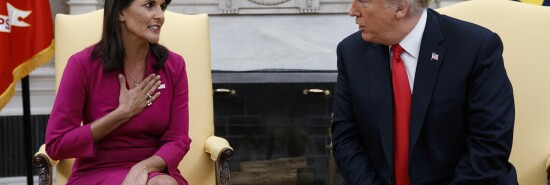
Haley, Trump, and a GOP race like no other
Byron York
HALEY, TRUMP, AND A GOP RACE LIKE NO OTHER. Former Gov. Nikki Haley (R-SC) announced her candidacy for the 2024 Republican presidential nomination this morning. Word was she would jump in at an event in Charleston tomorrow, but Haley scooped herself with the release of a 3.5-minute video that constitutes an announcement. The event in Charleston will essentially be a live re-announcement.
Haley’s move makes the 2024 Republican presidential primary race a real multicandidate race, with Haley joining former President Donald Trump, who entered the contest last November and has had it to himself ever since. Haley will likely be followed by several other Republicans, among them, perhaps, Gov. Ron DeSantis (R-FL), former Secretary of State Mike Pompeo, former Vice President Mike Pence, Sen. Tim Scott (R-SC), Gov. Glenn Youngkin (R-VA), Sen. Ted Cruz (R-TX), Gov. Chris Sununu (R-NH), and others.
Each one of them will be something of a first, or at least the first in a long time. In this way: No one alive has ever run a primary race against an out-of-office president seeking the White House a second, nonconsecutive time.
Subscribe today to the Washington Examiner magazine that will keep you up to date with what’s going on in Washington. SUBSCRIBE NOW: Just $1.00 an issue!
That will present a special problem: As all candidates do, they will talk about what they will do if they become president. Trump will talk about what he did as president. Some of them worked for Trump, and all were loyal to him. That will make for some interesting exchanges. Trump is already taking all sorts of shots at Haley.
But Trump has historical problems, too. In all of U.S. history, six presidents have left office and then made an effort to win their old job back. Five of them failed. The odds are not great.
The success is President Grover Cleveland, the only president ever to serve nonconsecutive terms. Cleveland was first elected in 1884, then lost his bid for reelection in 1888, then came back after four years out of office to win the White House in 1892.
That’s the optimistic side for Trump. The pessimistic side starts with Ulysses S. Grant. This is from the Pew Research Center: “Grant served two full presidential terms from 1869 to 1877 and, despite urgings from some in the Republican Party, declined to seek what would have been an unprecedented third term in 1876. But four years later, he changed his mind and sought the Republican nomination again. Although he led the field for nearly the entire GOP convention, Grant couldn’t win over a majority of the delegates to secure the nomination and ultimately lost to James A. Garfield on the 36th ballot.”
It’s important to note two things. First, that was long before the 22nd Amendment was ratified in 1951, limiting presidents to two terms, so Grant was free to run for a third. And second, it was before the primary system to determine presidential nominees, so most of the maneuvering to win the nomination took place at the party convention. In any event, Grant sought a nonconsecutive term and didn’t get it.
Then there was President Theodore Roosevelt. As vice president, he ascended to the presidency in 1901 when William McKinley was assassinated. He served the rest of McKinley’s term, then won a term on his own in 1904, and then chose not to run again in 1908. By 1912, he was eager for another shot. He tried to get the Republican nomination, but the sitting president and his chosen successor, William Howard Taft, won. Then Roosevelt created the Progressive Party to run as a third-party candidate. He lost that, too.
Then there was President Herbert Hoover, who after one term famously lost in a landslide in 1932 amid the Great Depression. Eight years later, in 1940, Hoover tried to win the Republican nomination again — and lost.
Then there was President Martin Van Buren, who was elected in 1836 and then ran and lost in 1840. In 1848, he tried again, but on a minor-party ticket. He lost. And finally, there was President Millard Fillmore, who as vice president succeeded President Zachary Taylor and then, in 1852, lost a bid for a term of his own. In 1856, he tried again as the “Know Nothing” party nominee. He lost again.
Times and circumstances are different, but the lesson here is simple. Having been president does not mean a former president can win the office again. In fact, there have been six attempts, with one success. Now, with Haley’s entry, the Republican primary race is truly underway, and we’ll see whether Trump has the ability to make history.
For a deeper dive into many of the topics covered in the Daily Memo, please listen to my podcast, The Byron York Show — available on the Ricochet Audio Network and everywhere else podcasts can be found. You can use this link to subscribe.
